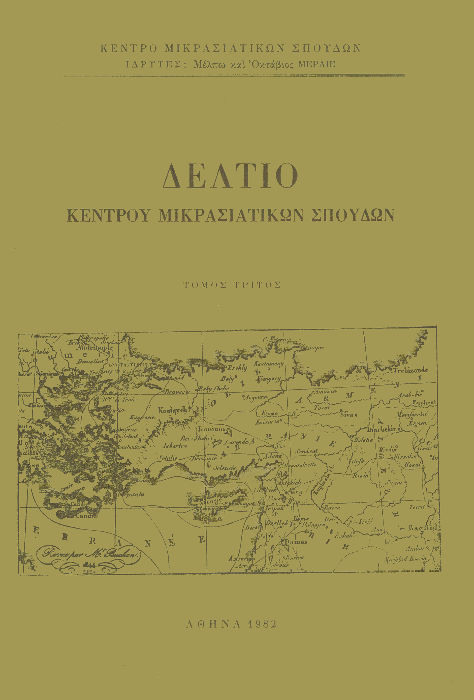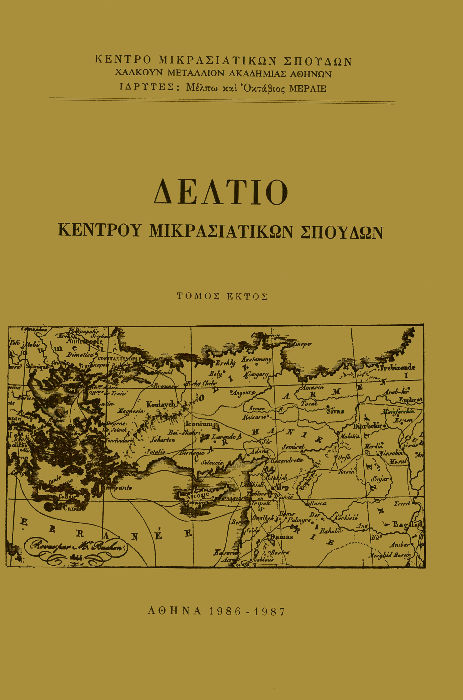Το έργο του Τούρκου χρονικογράφου Ασίκ-πασά Ζαδέ (c. 1400-c. 1486) ως πηγή της υστεροβυζαντινής και πρώιμης Οθωμανικής περιόδου
Περίληψη
A$ik-Pa$a-Zade (c. 1400 - c. 1486), the oldest and —perhaps— the
most important among the early Ottoman (Osmanli) chroniclers, composed
the «Tevarih-i Al-i Osman» (Chronicle of the House (=Dynasty)
of Osman), a lengthy (166 chapters) account of early Turkish history
from the early 13th century until the late 1450s, following the capture
of Constantinople (Istanbul) by the sultan Mohammed (Mehmet) II
«Fatih> (the «Conqueror») on 29 May, 1453.
The importance of this authentic work is immense, since it includes —
among others— a comparatively trustworthy (though sometimes impregnated
by fable and legend) account of the arrival of the early Osmanlis
in Anatolia, following their repulsion from inner Asia by the Mongols.
It also contains valuable pieces of information on the gradual expansion
of the Ottoman Sultanate in Asia Minor and the Balkan peninsula in the
course of the 14th and 15th centuries, as well as important details on
the policy pursued by the Conqueror concerning his Christian subjects.
Several manuscripts of the chronicle’s old Ottoman script (in Arabic
characters) survive in museums and libraries in Turkey (Top Kapi),
and its first ed. by Ali Bey (Istanbul 1914) was followed by two more
in the reformed latinized Turkish alphabet by F. Giese (Leipzig 1929)
and Ç. N. Atsiz (Istanbul 1949), while a German translation (with
commentaries) of the chronicle by R. F. Kreutel appeared in 1959
(Graz-Vienna).
Λεπτομέρειες άρθρου
- Πώς να δημιουργήσετε Αναφορές
-
Σαββίδης Α. Γ. (1982). Το έργο του Τούρκου χρονικογράφου Ασίκ-πασά Ζαδέ (c. 1400-c. 1486) ως πηγή της υστεροβυζαντινής και πρώιμης Οθωμανικής περιόδου. Δελτίο Κέντρου Μικρασιατικών Σπουδών, 3, 57–70. https://doi.org/10.12681/deltiokms.279
- Τεύχος
- Τόμ. 3 (1982)
- Ενότητα
- Άρθρα

Αυτή η εργασία είναι αδειοδοτημένη υπό το CC Αναφορά Δημιουργού – Μη Εμπορική Χρήση – Παρόμοια Διανομή 4.0.
Οι συγγραφείς των άρθρων που δημοσιεύονται στο Δελτίο διατηρούν τα δικαιώματα πνευματικής ιδιοκτησίας επί των άρθρων τους, δίνοντας στο περιοδικό το δικαίωμα της πρώτης δημοσίευσης. Άρθρα που δημοσιεύονται στο Δελτίο διατίθενται με άδεια Creative Commons 4.0 και σύμφωνα με την άδεια μπορούν να χρησιμοποιούνται ελεύθερα, με αναφορά στο/στη συγγραφέα και στην πρώτη δημοσίευση για μη κερδοσκοπικούς σκοπούς και με δικαίωμα τροποποίησης μόνον με παρόμοια διανομή (αν αναμείξετε, τροποποιήσετε, ή δημιουργήσετε πάνω στο υλικό, πρέπει να διανείμετε τις δικές σας συνεισφορές υπό την ίδια άδεια όπως και το πρωτότυπο).



